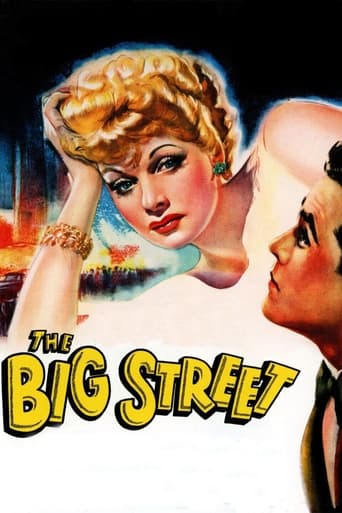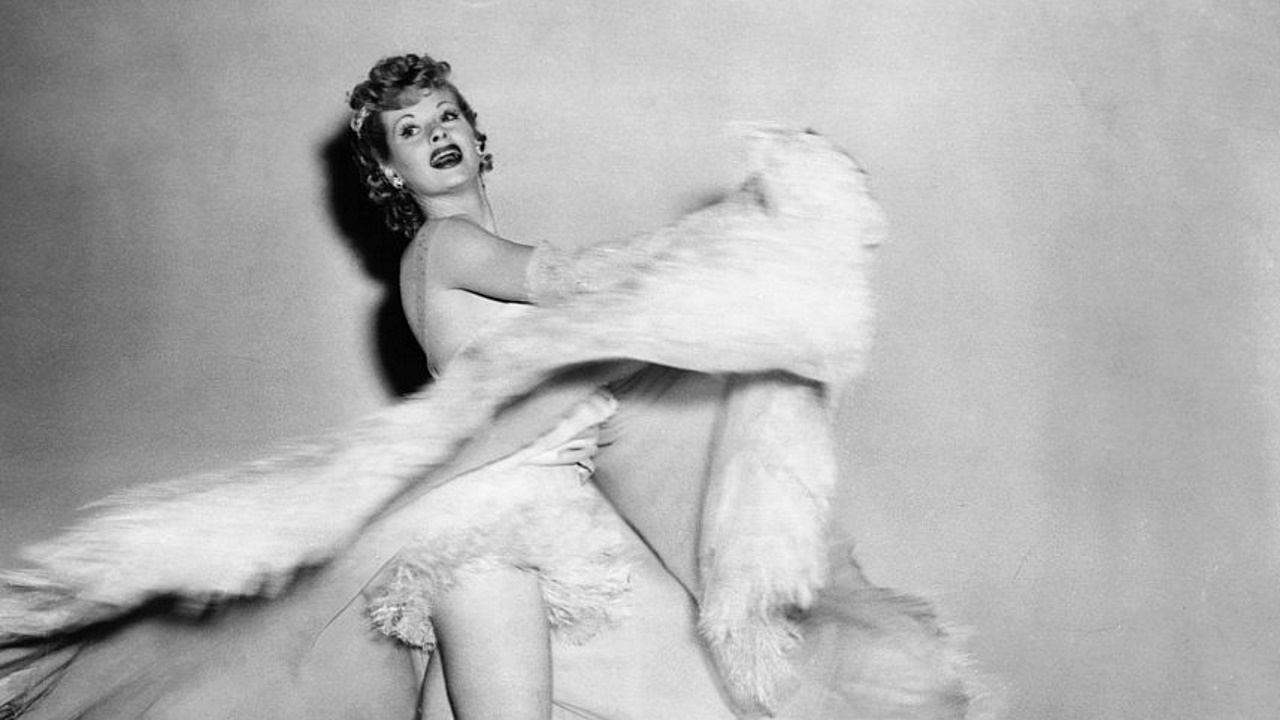atlasmb
Lucille Ball plays a callous chorine named Gloria Lyons who is undeservedly adored by a busboy named "Little Pinks" Pinkerton (Henry Fonda). She treats him--and most other people--like dirt, but he is willing to take abuse from the woman he worships.When Gloria faces adversity, Pinks is there to see her through it, but she remains a resolute bitch. Ball never acted better than in this role. Fonda portrays a favorite from his repertoire--the earnest man.Adapted from a story by Damon Runyon, the film is populated in part by those from the other side of the (race)track. Another reviewer implied that few would be familiar with the patois of Runyan, but any of the millions upon millions who have seen "Guys and Dolls" are already infinitely familiar with his peculiar but lovable vernacular. How does it all end? Will Pinks finally grow tired of his unappreciative goddess? Will he finally get the girl then regret it? I won't say. But it ends rather nicely nicely.
wes-connors
Broadway busboy Henry Fonda (as Agustus "Little Pinks" Pinkerton) idolizes self-centered lounge singer Lucille Ball (as Gloria "Your Highness" Lyons). When Ms. Ball falls on hard times, Mr. Fonda gets to lend a helping hand. The pair move to Florida, but tragedy follows
Although "Guys and Dolls" (1955) remains most representative, "The Big Street" captures the spirit of writer Damon Runyon's characters better than most Hollywood efforts, probably because Mr. Runyon produced.They weren't the author's first choice for the leads, but Fonda's innocent charmer and Ball's selfish tragedienne are exemplary characterizations. Ball is especially noteworthy, as she did not receive many opportunities to play against type, and places herself squarely on par with the more successful "Golden Age:" actresses of the 1930s and 1940s; she is startling. Director Irving Reis coordinates his fine cast and crew very well, making camera angles and movement seem uncommonly fresh.******** The Big Street (8/13/42) Damon Runyon : Irving Reis ~ Lucille Ball, Henry Fonda, Agnes Moorehead, Eugene Palette
beyondtheforest
I'm going to overlook a few minor flaws this film had and conclude, overall, it was great. It is a story of the unselfish love a 'Little' Busboy (Fonda) has for a beautiful and extremely popular nightclub singer (Ball). Ball initially has every rich man in town at her feet, from a powerful gangster to a wealthy glamor boy who she plans to marry. Her defining line of dialog is, "A girl's best friend is a dollar." She is somehow both cruel and yet sympathetic. She is fair to the busboy who saves her dog, thanking him and getting him a job, but then does not give him the time of day. She lives by the customs of society--and that does not include mixing in certain circles of 'little' people, such as busboys and maids.I think the more sensitive audiences will pick up on Ball's vulnerability. Why is she so concerned with money? Why does she snub people who are kind to her? If you follow the movie closely enough, the answers become apparent.When Ball's character is struck down by the gangster after she chooses to leave him, she is paralyzed from the waist down. It is revealed to the audience that she has no family or loved ones besides her dog that are willing to care for her. A sensitive audience would notice that detail and immediately understand her character. She has no one--that is why she is so hard. She is playing the social game to win--to snare a wealthy husband so she doesn't have to be frightened any more.The man she had her eyes on, after her accident, no longer had any interest in her. This is one of the most brutal and sad scenes in the film. We understand then why Ball was so eager not to be seen with the 'little' people; it was part of the social game she needed to play. When that same young man sees her with a group of her lowly friends, and in a wheelchair, a look of disgust enters his face, and Ball's heart shatters into a million pieces. As noted in the film, "That glamor boy doesn't have a sympathetic bone in his body." All of this is by way of countering arguments made by subsequent viewers that Ball's character is completely unsympathetic. Just the opposite is true. Her character is complex, deep, and vulnerable to the carelessness of the world around her. A world in which she has no family and no one loves her--that is, except Pinkerton (Fonda).Another magical scene occurs at the end of the film where it is revealed Ball can actually walk. The society that had judged and forgotten her so harshly because she was no longer able to walk stares on in amazement. But the fact she can walk proves she didn't need their acceptance at all. They were a superficial lot of people who didn't care about her at all.It is a magical and moving love story for the ages. A+ She
jotix100
Damon Runyon knew well that underbelly of Manhattan populated by colorful characters that made it into his stories for different magazines of his era. Mr. Runyon loved these people that could be seen in all the joints around Times Square creating a world of their own. "Little Pinks", the story in which picture was based, was produced by Runyon himself. The screenplay though, is by Leonard Spigelgass, and in part, it explains why the screen adaptation did not match Mr. Runyon's story. In fact, this is a hard project for anyone to translate the color and that underworld for a great audience.The story does not nothing that would endear it to the viewers because of the unsympathetic main character of Gloria Lyons, a chanteuse that was self-centered and didn't care for anyone but herself. Then, there is the other problem in how the noble Pinks, a suffering admirer, attends to her every whim, and who basically rescues her from a horrible end after her lover, Case Able causes her to depend on the kindness of strangers, or in this case, the loyal Pinks.Lucille Ball, who supposedly admitted this was one of her best films, made quite a departure when she accepted the meaty role of Gloria Lyons. This character didn't have any good qualities, yet, Ms. Ball did a fine job for bringing her to life. Henry Fonda, on the other hand, plays the naive man, who having fallen in love with this, apparently heartless woman, continues to cater to her, although Gloria never sees the goodness in him.The best thing about "The Big Street" is the great ensemble cast of characters actors that was amassed for it. The excellent Agnes Moorehead is paired with one of the best secondary actors of that era, Eugene Palette. They are wonderful as Violette and Nicely Nicely two people that deserved one another. Ray Collins and Sam Levene play pals that act more like they are enemies, since they always bet on opposite sides. Barton MacLane is perfect as Case Able. The sassy Louise Beavers plays the no-nonsense maid, Ruby.There are a lot of familiar faces in the picture that were not given credit, yet, we recognize their faces. Hans Conreid, Chet Huntley, and Marie Windsor are some of the ones we recalled watching the film. Irving Reis, the director kept things moving at a nice pace in this film that should be seen like a curiosity.



 AD
AD



